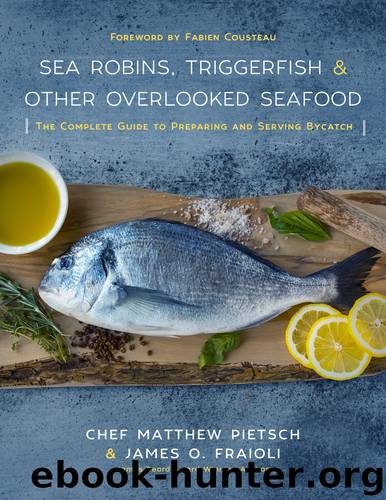Sea Robins, Triggerfish & Other Overlooked Seafood by Matthew Pietsch

Author:Matthew Pietsch
Language: eng
Format: epub
Publisher: Skyhorse Publishing
Published: 2017-03-17T04:00:00+00:00
FLOUNDER
There are many species of flounder that find their way to dinner tables across America, including Dover, English, starry and petrale. Soles, sanddabs, flukes, and plaice are also part of the flatfish family and may also be grouped into the “flounder” name.
Flounder, like all flatfish, are bottom-dwellers with wide, flat bodies and eyes on the top of the head, which enables them to see predators and prey while laying camouflaged on the muddy or sandy ocean floor. Because they feed on the bottom, flounders are very susceptible to bottom trawlers and bottom gill nets in which the flounder become bycatch when not being targeted specifically. When purchasing flounder, try to avoid those from the New England fishery or the US North and Mid-Atlantic. These areas have been overfished, while those flounders landed on the West Coast, particularly California and Alaska, are much more sustainable options.
Fortunately, innovative gear design and fishing behavior is helping today’s trawlers avoid bycatch hotspots while keeping sensitive species out of nets.
Flounder is sold as whole fish or thin fillets, which are typically skinned. They are also low in mercury.
FLOUNDER
1 large carrot, peeled and ends trimmed
4 (6-ounce) flounder fillets, cleaned and trimmed
2 cups all-purpose unbleached flour
4–6 ounces clarified butter or neutral-flavored oil (canola or grapeseed)
Kosher salt, as needed
Coarse flake or sea salt, as needed
Salt-Cured Celery (page 108)
Sweet Pickled Pear Onions (page 173)
BROWN BUTTER SAUCE
Makes ¾–1 cup
4 cups heavy cream
1 lemon, juiced
Fine sea salt, as needed
TO MAKE THE FLOUNDER:
First, shave the carrot into long strips, using a French mandolin, Japanese mandolin, or simply a vegetable peeler. Place the carrot strips into a bath of ice water, and allow to chill for 10 to 15 minutes prior to serving. The carrot should curl into interesting shapes and curves. Dry well before plating.
Towel-dry the fish well prior to cooking. Place the flour in a large, shallow baking dish. Do not flour the fish until ready to cook.
Place a large sauté pan over medium to medium-high heat. Allow the pan to heat for 1 or 2 minutes. Add the clarified butter or oil to the pan, and allow to heat for 30 to 60 seconds.
Season the fish well with the kosher salt, and dust immediately in the flour, being sure to remove any excess flour from the fish. Place the fish carefully into the hot pan. Once lightly golden brown, turn the fish using a fish spatula and finish cooking the other side. Remove the fish from the pan and sprinkle immediately with coarse flake salt.
TO MAKE THE BROWN BUTTER SAUCE:
In a small, heavy-bottomed saucepot (3- or 4-quart), add the cream and bring to a boil. Note: the cream will easily “boil over” if not attended to, so stir the cream and reduce the temperature slightly to keep the cream from spilling over the sides of the pot. Continue to cook the cream at the highest manageable temperature, slowly reducing the moisture contained in the cream. As the cream thickens and reduces, decrease the heat to a simmer and continue to stir.
Download
This site does not store any files on its server. We only index and link to content provided by other sites. Please contact the content providers to delete copyright contents if any and email us, we'll remove relevant links or contents immediately.
The Sprouting Book by Ann Wigmore(3415)
Better Homes and Gardens New Cookbook by Better Homes & Gardens(3373)
Trullo by Tim Siadatan(3306)
Super Food Family Classics by Jamie Oliver(3250)
Panini by Carlo Middione(3166)
Hedgerow by John Wright(3110)
Bread Revolution by Peter Reinhart(2993)
Sauces by James Peterson(2967)
Jam by Jam (epub)(2881)
Ottolenghi - The Cookbook by Yotam Ottolenghi(2740)
Oh She Glows Every Day by Angela Liddon(2634)
My Pantry by Alice Waters(2438)
Hot Sauce Nation by Denver Nicks(2375)
The Culinary Herbal by Susan Belsinger(2339)
Veg by Jamie Oliver(2308)
The Art of Making Gelato by Morgan Morano(2162)
Wanderlust by Jeff Krasno(2148)
Meathooked by Marta Zaraska(2148)
Basic Illustrated Edible and Medicinal Mushrooms by Jim Meuninck(2133)
